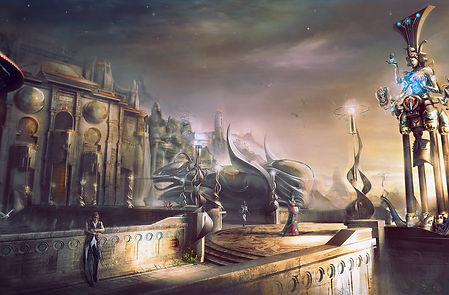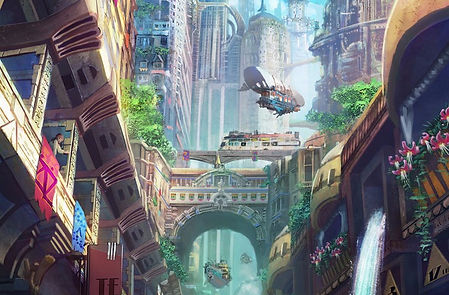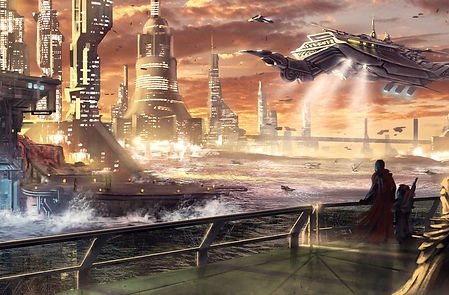

THE CITY OF
ATLANTIS
Location
For hundred of years, research was dominated by debates concerning the location of the legendary nation of Atlantis. Most theories of its placement centered on the Mediterranean, but several scientists argued for other locations, be it the Middle East, in the Black Sea, Morocco, Great Britain, Denmark, the Americas, Antarctica or somewhere entirely different.
In reality, Atlantis is located right in the middle of the North Atlantic Ocean, between the American, European and African continent. Some scholars believe that thousands of years ago, it used to be closer to either the American or European continent and has moved since then, but little evidence could be found to support this claim. Rumour has it the Atlantean government actually destroyed such proof to claim Atlantis has always been independent, its own continent and not just an ordinary island like others.
Distance to other places:
-
Washington, D.C., US: 2018.529 miles
-
Brasília, Brazil: 3540.577 miles
-
Lagos, Nigeria: 3414.647 miles
-
Brussels, Belgium: 2483.572 miles
History
Atlantis' history dates back at least ten thousand years. Back then, it was simply another civilisation in the world, but through extensive research its citizens have been able to invent technology far superior to anything other races could have built, allowing them to become the most powerful nation of all. At the height of their power, Atlantis was known across the world and referenced by philosophers such as Plato. However, one day the city suddenly disappeared from the surface and consequently from the minds of the humans. Until recently, it was thought to be a myth, but in July 2015 Atlantis rose from the depths of the ocean and revealed its existence to the surface world.
Read a more detailed timeline here.

General information
Atlantis has a population of roughly 3 million people in an area of 940 km2 (362.934 sq mi). The nation is divided into four circles, all but one further divided into four 'districts'.
Located in the Subtropics, Atlantis' climate is similar to that of Bermuda. It experiences hot and humid summers with the majority of precipitation falling from isolated showers and thunderstorms. Winters are mild with temperatures rarely falling below 10°C (50°F). The highest temperature officially observed in Atlantis was 34°C (93°F), though the high air humidity often results in a heat index that would be considered dangerous, particularly for strenous activities in the sun. Additionally, though sub-freezing temperatures have never been observed, the strong winds following winter-season cold fronts can result in wind chill values below actual air temperature.
Atlantis is rich in flora and fauna of kinds never before seen. Animals that are thought to be extinct or pure fantasy can be found around the city - from kikedogat to akthoeth, naneme or akkoak. These animals were relatively widespread before, but just like magic, knowledge of their existence sunk with Atlantis to the bottom of the ocean.
The city is highly technologised, combining magic and futuristic machines to fully support itself. Oxygen was produced through trees and plants, which are grown in the city's biotope; they also provide the city with fruits and vegetables. Surrounding water and sunlight are used as sources of energy as well as magic itself. Through deep sea mining, the city has access to a variety of minerals and metals, which in turn are used for further production. Animals have been brought to the island and are raised in small farms.
While the city was underwater, it was surrounded by thick magical glass protecting it from the pressures at such depth. Life support systems - temperature, humidity and air composition - were monitored through special machines. Drinking water was created by using condensation and desalinisation. (Human) Waste was treated, released into the environment or cooked down to a fine ash.
City map
The Inner Circle

Atlantis' inner circle has hardly changed over the years. Its buildings reflect traditional Atlantean architecture while perfectly integrating modern technology. Because of cultural exchange that took place thousands of years ago, many houses are reminiscent of classical Greek architecture, combined with influences from other cultures such as the Mayan or Cambodian. Houses are made from marble and stone, and are richly ornamented, sometimes even with jewels and other precious stones. There are trees, seas of flowers and small parks that offer something vibrant and organic in the white and blue façades of the buildings.
In the middle of the district stands an enormous temple, called the Heart of Atlantis or the Inner Sanctum. It serves a variety of purposes: The temple is the cult center of Atlantean spiritual life, where believers gather to meditate, study and pray, and is home of the Atlantean library. Secondly, it is here that the government gathers. As Atlantean society is a hierocracy, the government consists of priests, who in turn are led by two diarchs as the joint heads of state. In their position as the only political faction, fulfilling the roles of magistrates, officials and the like, priests are capable of controlling everything in the city, both in public and private life, as well as the distribution of Silitan.
While eres live in the inner circle, the second circle is home of the "common people" - all citizens of Atlantis that are neither priests nor guards. It is the largest of all the circles and a colorful mixture of traditional architecture and modernity; high rise buildings stand next to old, small and temple-like houses, Atlantean symbols are embedded in glass façades and statues of the gods rise as far up as the aircrafts and skyscrapers. Due to the amount of people living in the city, there aren't any single family houses in the second circle; instead, every citizen owns an apartment in one of the many housing complexes. Unlike in other large cities, the skyscrapers do not make the city feel small and overcrowded, as the whole circle was built to accomodate an huge number of people and still allow them to feel comfortable.
While all apartments cost the same, therefore should be fairly identical, architects tried their best in making each unique and something special. Residents use decorations and interiors to give their homes an exclusive touch, making it theirs only.
The Second Circle

The Third Circle

Next to the outer circle, Atlantis' third circle is the most modern in terms of its function - here you can find the biotope, the city's medical district, entertainment venue, restaurants, schools, the University of Atlantis and various research facilities.
The third circle combines several aspects of social life in one: Science and research, medicine, education
All of Atlantis' businesses and industrial facilities are located in the outer of the four circles. Before Atlantis sunk to the bottom of the ocean, all trading with foreign countries took place on the water, meaning it was best to built shops close to the port. Due to their love for tradition, this layout was never changed and even though the city didn't trade with other nations anymore, its shopping area stayed where it has always been. Over time, as Atlantean industry grew, the circle was expanded and became more and more modern. Nowadays, the outer circle looks like it belongs on the set of a sci-fi movie, but nevertheless the people never lost sight of their traditions. Elements of classical Atlantean architecture can easily be found around every corner, creating a perfect symbiosis between modernism and tradition.
It is important to note that for all its sci-fi
In the outer circle, the streets are always crowded, but never too full. With a sheer endless number of businesses - from enchantment shops such as The Rune, the Silver Arcades, the traditional floating market of Thokitebe channel or the Great Market to restaurants like Seawise or the Kingdom of Nekeiy -
In addition to this, the city guards' HQ and their homes can be found in the outer circle as well. Some guards prefer living together with their family in the second circle, but most move into one of the apartments provided by the administration after finishing their training. Recruits live together in small dormitories right next to the headquarters.
The Outer Circle

Bridges

All of the circles are connected through bridges, which have been there for as long as the city and were only repaired, but never 'updated' or changed. There are three different types of bridges: Channels through which boats and small ships can move around the city (as seen in the picture), train connections between each circle, and air lanes for flying vessels.
There is no need for streets that connect each circle with the others, as cars do not exist. Citizens get around by train, flying machines or more commonly by foot. Travelling around was made easy and comfortable through different inventions - elevators, trains or moving walkways - and due to there not being any cars, there's also no such thing as traffic jams.
Protecting the city from enemies and natural disasters such as flood waves, Atlantis' City Wall goes all the way around the city and reaches high up into the sky. It's impossible to get around it, limiting entrance to Atlantis to the large eastern and western gates. You can't simply fly over it either; guards keep watch and would not hesitate to shoot down any unauthorised vessel that crosses the wall. In case of emergency, an unknown number of weapons has been integrated into the wall, making it possible to defend the city long before enemies reach it.
The City Wall

Important locations

An architectural masterpiece, Atlantis’ Inner Sanctum is the heart and jewel of the city. Made from beautiful marble and richly ornamented with precious stones, it is evidence of the priests’ influence and power. Citizens come here to meditate, ask for spiritual guidance or study in the Atlantean library. What happens inside the temple is relatively unknown, for the priests keep their inner workings a secret, known only to other members.

The Atlantean Center for the Study of Magic is a research facility, and has been the location of the most notable technological and magical breakthroughs in Atlantean history. Its discoveries helped shape fields such as technology, science and medicine significantly. Scientists and scholars work tirelessly to discover even more of the secrets of magic, and try to invent new technologies that greatly improve the citizens' lives. In addition, Silitan is produced here.

A luxury hotel built only months before Atlantis reappeared, Anchor Hotel provides affordable lodging, meals, and other guest services for foreigners. The hotel consists of several rooms, suits and penthouses with accomendations that reflect the finest the world has to offer, with luxurious restaurants, bars, swimming pools, fitness and spa facilities and more. Unfortunately, hidden cameras are installed everywhere.

An architectural masterpiece, Atlantis’ Inner Sanctum is the heart and jewel of the city. Made from beautiful marble and richly ornamented with precious stones, it is evidence of the priests’ influence and power. Citizens come here to meditate, ask for spiritual guidance or study in the Atlantean library. What happens inside the temple is relatively unknown, for the priests keep their inner workings a secret, known only to other members.







